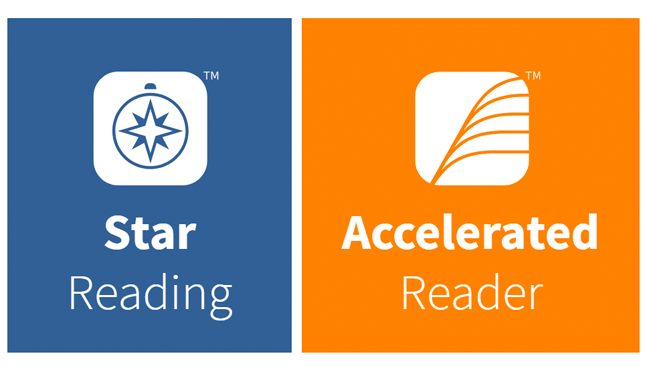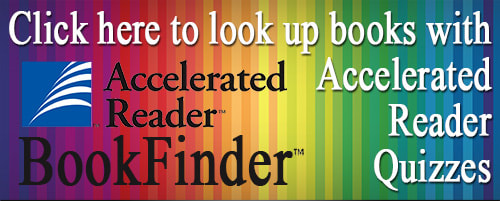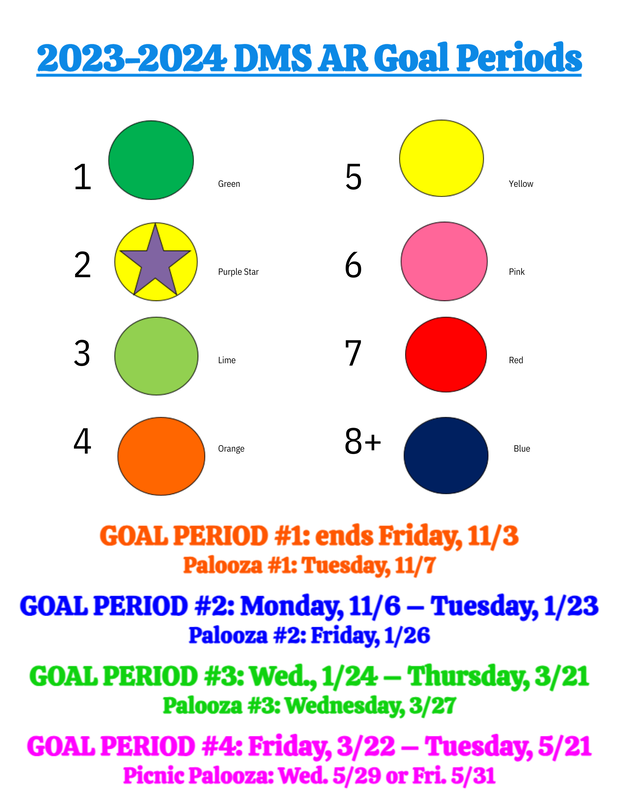|
This FAQ sheet explains the ELA tools available.
See or email Mrs. Papiano for further help: [email protected] |
STUDENT INFORMATION |
PARENT INFORMATION |
OVERVIEW OF THE ACCELERATED READER PROGRAM:
Renaissance Place is the home of Accelerated Reader. Delsea Middle School subscribes to and uses the Accelerated Reader's STAR assessment to first assist teachers in acquiring data on each student’s reading level. With this information, the teacher can monitor a student’s reading and guide progress towards their formulated reading goal for the goal period.
Every book that has an Accelerated Reader Reading Practice Quiz is given a point value. Titles in our library collection that have corresponding AR quizzes are identified by reading level using a colored sticker on the spine and the point value that can be earned from each item is written inside the flyleaf of the book. The title, author, book level, point value, quiz number, and interest level can be searched for and obtained for print and digital books in the Destiny library catalog and the MackinVIA digital catalog.
In independent literature-based reading, ZPD is the range of books that will challenge a child without causing frustration or loss of motivation. Your child will receive a ZPD range after taking a STAR Reading assessment. It’s important for children to read books with a high degree of comprehension and within their ZPDs. The AR program encourages students to read a variety of books within their comfort level and then strategically challenges them to move into higher levels. ZPDs should be adjusted based on the needs/progress of your child. Destiny and MackinVIA allows the option for teachers and students to search these programs for AR books and limit their search to their reading level. AR Bookfinder is a database of all titles that have a corresponding AR quiz, however, DMS may not have that book in their Destiny or MackinVIA collection.
According to research, children who read at least 20 minutes a day with a 90% comprehension rate (average percent correct) on AR quizzes see the greatest gains. Time given during Sustained Silent Reading during homeroom and during English class periods provides students with opportunities to read daily.
Students take AR comprehension quizzes after they read each of their books and earn points towards their goals based on their quiz results.
The Purpose of Accelerated Reader:
What is the ATOS Readability Formula?
An ATOS level on a book indicates how difficult the text is to read. Accelerated Reader uses the ATOS Readability Formula to help teachers guide student reading practice by assigning a readability level (book level) to books. The ATOS Readability Formula is one of the most widely used measures for judging the difficult level of text. The product of extensive research, the formula employs several unique features:
Sources:
STAR Enterprise Reading Assessment
How Accelerated Reader Works
Renaissance Learning: Advanced Technology for Data-Driven Schools
Renaissance Accelerated Reader
Empirically-Validated Learning Progressions Built into the Renaissance Program
Text Complexity
Focus Skills
*DMS does not limit students to just reading Accelerated Reader materials at their reading level. We also support choice reading.
Every book that has an Accelerated Reader Reading Practice Quiz is given a point value. Titles in our library collection that have corresponding AR quizzes are identified by reading level using a colored sticker on the spine and the point value that can be earned from each item is written inside the flyleaf of the book. The title, author, book level, point value, quiz number, and interest level can be searched for and obtained for print and digital books in the Destiny library catalog and the MackinVIA digital catalog.
In independent literature-based reading, ZPD is the range of books that will challenge a child without causing frustration or loss of motivation. Your child will receive a ZPD range after taking a STAR Reading assessment. It’s important for children to read books with a high degree of comprehension and within their ZPDs. The AR program encourages students to read a variety of books within their comfort level and then strategically challenges them to move into higher levels. ZPDs should be adjusted based on the needs/progress of your child. Destiny and MackinVIA allows the option for teachers and students to search these programs for AR books and limit their search to their reading level. AR Bookfinder is a database of all titles that have a corresponding AR quiz, however, DMS may not have that book in their Destiny or MackinVIA collection.
According to research, children who read at least 20 minutes a day with a 90% comprehension rate (average percent correct) on AR quizzes see the greatest gains. Time given during Sustained Silent Reading during homeroom and during English class periods provides students with opportunities to read daily.
Students take AR comprehension quizzes after they read each of their books and earn points towards their goals based on their quiz results.
The Purpose of Accelerated Reader:
- The purpose of Accelerated Reader is to enable powerful practice.
- A student’s ZPD represents the level of difficulty that is neither too hard nor too easy.
- Book level indicates the difficulty of text, not the maturity of content.
- Interest level tells you for which grade levels a book’s themes and ideas are appropriate.
- The points of a book are computed based on the difficulty of the book (ATOS readability level) and the length of the book (number of words). The number of points a student earns tells you how much reading a student has done.
- The most important factor in accelerated reading growth is good comprehension.
What is the ATOS Readability Formula?
An ATOS level on a book indicates how difficult the text is to read. Accelerated Reader uses the ATOS Readability Formula to help teachers guide student reading practice by assigning a readability level (book level) to books. The ATOS Readability Formula is one of the most widely used measures for judging the difficult level of text. The product of extensive research, the formula employs several unique features:
- Takes into account characteristics that most heavily influence readability (average sentence length, average word length, and word difficulty level)
- Utilizes a graded vocabulary list number more than 100,000 words
- Bases analyses on worlds largest database of words from actual books (more than 170,000 books comprising nearly 2.5 billion words)
Sources:
STAR Enterprise Reading Assessment
How Accelerated Reader Works
Renaissance Learning: Advanced Technology for Data-Driven Schools
Renaissance Accelerated Reader
Empirically-Validated Learning Progressions Built into the Renaissance Program
Text Complexity
Focus Skills
*DMS does not limit students to just reading Accelerated Reader materials at their reading level. We also support choice reading.






